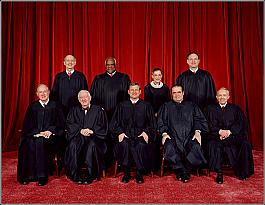The National Coalition Against Censorship and the College Art Association recently filed an amici curiae brief in United States .v Stevens in the Supreme Court. Although the subject matter – images of animal cruelty – is extremely distasteful, the case raises critical First Amendment questions that would affect a wide variety of valuable expression and undermine fundamental constitutional principles. In addition, the law is unnecessary to protect animals from cruel and abusive treatment. Every state in the country prohibits cruelty to animals. NCAC and CAA endorse these laws and think they are the best way to protect both animals and our constitutional rights.
The importance of the constitutional issues is apparent from the large diverse group of organizations that have filed amicus briefs arguing that the law is unconstitutional.
NCAC and CAA’s brief focuses on the potential effects of this statute on artistic expression. Because the statute is so open-ended, it could include any image of animal cruelty, even if the underlying acts were legal when and where they occurred. Pictures of bull fights are one example. Documentary footage of dog fights, fox hunts, and cockfights would also be at risk.
In addition to historical and documentary footage, several well-known and highly respected artists have created works that raise questions about the relationship between humans and animals, including the ethical dimension of legalized slaughter of animals for food, clothing and other products. Some of these works are difficult to watch and to understand and would undoubtedly be offensive to some viewers. That does not mean that they lack artistic or other value, or that they should be banned as long as no law was broken in creating the works.
The government claims that the statute is constitutional because works with serious value will fall under an exception in the statute. This does not solve the problem, however. The whole purpose of the First Amendment is to protect unpopular, controversial, and even hateful and repulsive speech. It establishes an individual right that cannot be defeated by popular opinion, even majority opinion, and that is its most critical characteristic. This statute, however, leaves the determination about what expression is protected and what is not to a jury. This is the “tyranny of the majority” that the Bill of Rights was designed to prevent.
In this country, we punish what people do, not what they think, say, draw or record in film. Prosecutors would use their time better targeting the people who actually abuse animals, rather than those who record the fact that such behavior exists.
To read NCAC’s brief, click here.
Organizations that have filed amicus briefs arguing that the law is unconstitutional:
Association of American Publishers, Inc.
Association of American University Presses
American Booksellers Foundation for Free Expression
American Civil Liberties Union
American Dog Breeders Association
American Society of News Editors
American Society of Media Photographers
Association of Alternative Newsweeklies
CATO Institute
Center for Democracy and Technology
Citizen Media Law Project
Comic Book Legal Defense Fund
Congressional Sportsmen Foundation
DKT Liberty Project
Endangered Breed Association
Entertainment Consumers Association
Entertainment Merchants Association
Film Independent
1st Amendment Lawyers
Freedom to Read Foundation
Independent Book Publishers Association
Independent Filmmakers Project
Independent Film & Television Alliance
International Documentary Association
Media NewsGroup, Inc.
National Association of Recording Merchandisers
National Association of Theater Owners, Inc.
National Press Photographers Association
National Public Radio, Inc.
National Rife Association of America, Inc.
National Shooting Sports Foundation, Inc.
New York Times Company
Newspaper Association of America
Newspaper Guild-CWA, North American Nature Photography Association
Outdoor Writers Association of America
Pen American Center
Pennsylvania Outdoor Writers Association
Radio-Television News Directors Association
Reporters Committee for Freedom of the Press and Thirteen News Media Organizations
Professional Outdoor Media Association
Safari Club International
Society of Environmental Journalists
Society of Professional Journalists
Southeastern Outdoor Press Association
Texas Outdoor Writers Association
Thomas Jefferson Center for the Protection of Free Expression


